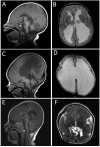Infantile hydrocephalus: a review of epidemiology, classification and causes
- PMID: 24932902
- PMCID: PMC4334358
- DOI: 10.1016/j.ejmg.2014.06.002
Infantile hydrocephalus: a review of epidemiology, classification and causes
Abstract
Hydrocephalus is a common but complex condition caused by physical or functional obstruction of CSF flow that leads to progressive ventricular dilatation. Though hydrocephalus was recently estimated to affect 1.1 in 1000 infants, there have been few systematic assessments of the causes of hydrocephalus in this age group, which makes it a challenging condition to approach as a scientist or as a clinician. Here, we review contemporary literature on the epidemiology, classification and pathogenesis of infantile hydrocephalus. We describe the major environmental and genetic causes of hydrocephalus, with the goal of providing a framework to assess infants with hydrocephalus and guide future research.
Keywords: Aqueductal stenosis; Genetics; Hydrocephalus; Intraventricular hemorrhage; L1CAM.
Copyright © 2014 Elsevier Masson SAS. All rights reserved.
Figures


References
-
- Raimondi AJ. A unifying theory for the definition and classification of hydrocephalus. Childs Nerv Syst. 1994;10(1):2–12. - PubMed
-
- Schrander-Stumpel C, Fryns JP. Congenital hydrocephalus: nosology and guidelines for clinical approach and genetic counselling. Eur J Pediatr. 1998;157(5):355–62. - PubMed
-
- Munch TN, et al. Familial aggregation of congenital hydrocephalus in a nationwide cohort. Brain. 2012;135(Pt 8):2409–15. - PubMed
-
- Damkier HH, Brown PD, Praetorius J. Cerebrospinal fluid secretion by the choroid plexus. Physiol Rev. 2013;93(4):1847–92. - PubMed
Publication types
MeSH terms
Grants and funding
LinkOut - more resources
Full Text Sources
Other Literature Sources
Medical

